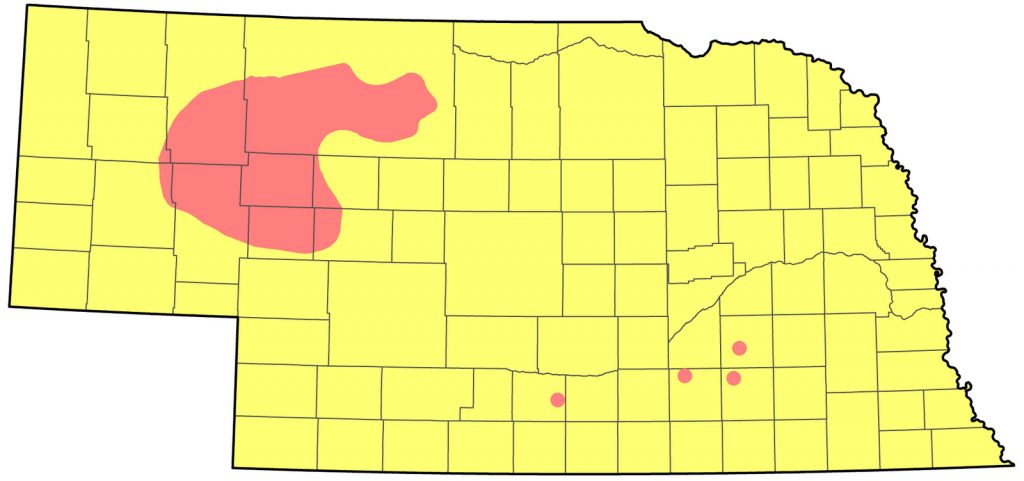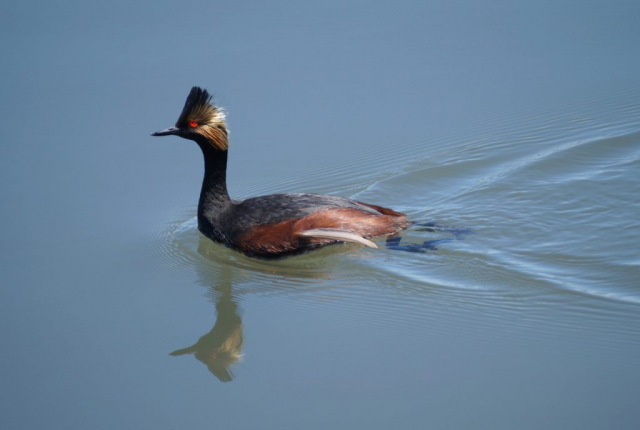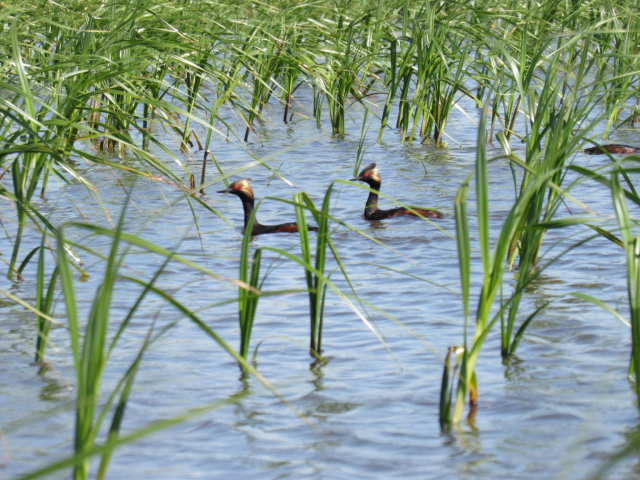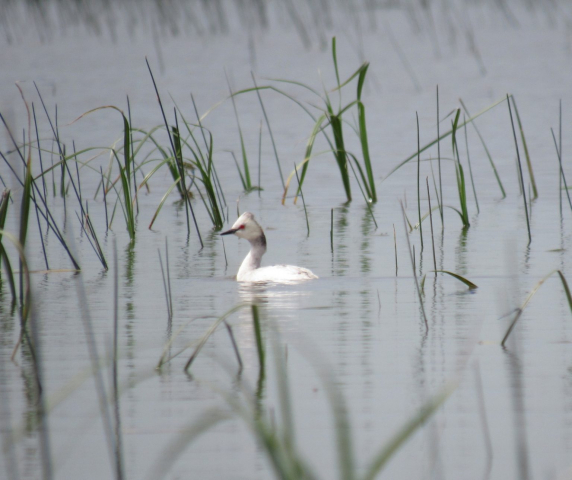Podiceps nigricollis californicus
Status: Common regular spring and fall migrant central and west, fairly common east. Common regular breeder north and west, rare southeast. Rare casual summer visitor south and east.
Documentation: Specimen: UNSM ZM6006, 25 Sep 1927 Lancaster Co.

Taxonomy: Three subspecies are recognized: californicus in North and Central America, gurneyi in Africa, and nigricollis in Eurasia (AviList 2025).
Nebraska birds are californicus.
A leucistic Eared Grebe was photographed at Harvard WPA, Clay Co 17 Jun 2019 (Jorgensen and Brenner 2019).
Spring: Mar 14, 15, 15 <<<>>> Jun 12, 13, 13
The main migratory movement occurs mid-Apr through early May. Last dates above are away from the breeding range; such reports are few after mid-May. There are earlier reports 22 Feb 1998 Lake McConaughy, Keith Co, 5 Mar 2016 Lancaster Co, eight on 8 Mar 2006 at Harlan Co Reservoir, Harlan Co, and one at Branched Oak Lake, Lancaster Co 11 Mar 2021.
- High counts: 1240 at Lake Minatare, Scotts Bluff Co 4 May 2022, 1045 at Box Butte Reservoir, Dawes Co 25 May 2021, 460 at North Platte WTP, Lincoln Co 2 May 2004, 450 at Crescent Lake NWR, Garden Co 12 May 1999, and 392 in Sheridan Co 18 May 2004.
Summer: Breeding is highly dependent on suitable water conditions (Sharpe and Payne 1966). The current breeding range is the western Sandhills, with breeding in the Rainwater Basin increasing since 2007. The eastern extent of regular breeding in the Sandhills appears to be in Cherry Co (Ducey 1988); Blake and Ducey (1991) gave no records for Holt Co, calling it a “possible summer resident” only. Mollhoff (2022) cited several records in Douglas and Otoe Cos 1888-1889, but there are none since.
Nesting was confirmed for the Rainwater Basin in 2007; a nest with three eggs was at Funk WPA, Phelps Co 2 Jul 2007 (Mollhoff 2008). This may have been the first record of attempted nesting south and east of the central Sandhills since Brooking found a nest with eggs at Inland, Clay Co 2 Jun 1916, these now #116793 at Peabody Museum, Yale University, CT (Mollhoff 2022). In 2008, two nests were discovered at Kirkpatrick Basin North WMA, York Co on 22 Jun; additional nesting records from the Rainwater Basin include a pair (two of 14 birds present) building a nest at Waco/Spikerush WMAs, York Co 26 May 2007 and one (of 28 present) “exhibiting nesting behavior” at Harvard WPA, Clay Co 28 May 2007. Only the fifth accepted Rainwater Basin nesting record, and first modern successful breeding record there, was at Marsh Hawk WMA, Fillmore Co 3 Jul 2015; there were 11 nests with eggs, but by 9 Aug most nests were abandoned and only one pair with young was seen (Jorgensen 2016). Summer 2019 was an “unprecedented nesting season” for this species in the Rainwater Basin; Eared Grebes were discovered nesting at six sites, four in Clay Co and one each in Fillmore and York Cos, with successful breeding documented at four of these sites, three in Clay Co and one in Fillmore Co (Jorgensen and Brenner 2019).
There are several additional breeding season reports from the Sandhills (away from regular western Sandhills breeding areas) and Rainwater Basin without definitive evidence of breeding activity including five from Lincoln Co since 1972, and from Keith Co, where a report without details of breeding on Keystone Lake in 1977 is best considered hypothetical (Rosche 1994, Brown and Brown 2001), although 1-2 were present through summer 2001 at Lake Ogallala, Keith Co and another was there 19 Jun 2004. In 2025 at least seven were reported at Lake Ogallala and Lake McConaughy 19-28 Jun without nesting evidence. A pair was noted on the Oshkosh SL, Garden Co, “a likely breeding location” 17 Jul 1988 (Rosche 1994). One was in Loup Co 11 Jul 2020.
Summer reports (14 Jun-9 Aug) away from the breeding range and the Lake McConaughy area are few; there are eight reports 15-28 Jun, and early Aug records are cited below under Fall. The few Jul records are 2 Jul 2014 Sutherland Reservoir, Lincoln Co, 6 Jul 2017 Perkins Co, 10 Jul 2021 four North Platte WTP, Lincoln Co, and 24 Jul 2016 Lake Ogallala.
- Breeding Phenology:
Nest-building: 28 May
Eggs: 2 May- 11 Aug (Mollhoff 2022)
Dependent young: 17 Jun-20 Jul - High counts: 1295 at Crescent Lake NWR 4 Jun 2020, 1105 at Goose Lake, Crescent Lake NWR 9 Jun 2021, 932 there 10 Jul 1997, 800 there 10 Aug 2019, and 740 there 18 Aug 2020.
On occasion, large concentrations of nests occur, such as a colony in Cherry Co with 600-700 pairs (Mollhoff 2001) and 250 nests with 500 adults at Valentine NWR, Cherry Co 9 Jun 1982 (McDaniel; Mollhoff 2022). Average colony size is 122 nests (Mollhoff 2022).
Fall: Aug 10, 11, 11 <<<>>> Dec 14, 14, 14
Early dates above are away from the breeding range.
Earlier dates are 21 Jul 2000 (45) at North Platte WTP, Lincoln Co, 31 Jul 2013 Branched Oak Lake, Lancaster Co, 4 Aug 2008 Lincoln Co, 5-6 Aug 2000 at Harlan Co Reservoir, and two at North Platte WTP 6 Aug 2023. 1-2 that summered in Pierce Co 2019 were still present 17 Aug.
Peak movement occurs in Oct.
Later dates are 18 Dec 2010 Lincoln Co, 2-19 Dec 2015 Lancaster Co, two at Lake Ogallala 12-14 Dec 1998 which apparently remained until 2 Jan 1999 (Jorgensen 2001), 23 Dec 2024-1 Jan 2025 Lake Ogallala, and 30 Dec 1928-20 Jan 1929 Adams Co (Jorgensen 2012).
- High counts: 487 in the western Panhandle 16 Oct 1999, 80 at Lake Minatare, Scotts Bluff Co 13 Aug 2022, 77 at Box Butte Reservoir, Dawes Co 20 Sep 2000, 76 at North Platte NWR, Scotts Bluff Co 7 Oct 2022, and 69 at Sutherland Reservoir, Lincoln Co 7 Nov 1994.
Images
Abbreviations
NWR: National Wildlife Refuge
SL: Sewage Lagoons
UNSM: University of Nebraska State Museum
WMA: Waterfowl Management Area (State)
WPA: Waterfowl Production Area (Federal)
WTP: Water Treatment Plant
Literature Cited
AviList Core Team, 2025. AviList: The Global Avian Checklist, v2025. https://doi.org/10.2173/avilist.v2025.
Blake, L., and J. E. Ducey. 1991. Birds of the eastern Sandhills in Holt County, Nebraska. NBR 59: 103-132.
Brown, C.R., and M.B. Brown. 2001. Birds of the Cedar Point Biological Station. Occasional Papers of the Cedar Point Biological Station, No. 1.
Ducey, J.E. 1988. Nebraska birds, breeding status and distribution. Simmons-Boardman Books, Omaha, Nebraska, USA.
Jorgensen, J.G. 2001. 1999 (Eleventh) Report of the NOU Records Committee. NBR 69: 85-91.
Jorgensen, J.G. 2012. Birds of the Rainwater Basin, Nebraska. Nebraska Game and Parks Commission, Lincoln, Nebraska, USA.
Jorgensen, J.G. 2016. A summary of 2015 breeding bird surveys of selected Rainwater Basin wetlands. Nongame Bird Program of the Nebraska Game and Parks Commission, Lincoln, Nebraska, USA.
Jorgensen, J.G., and S.J. Brenner. 2019. Notable avian nesting records from the Rainwater Basin, Nebraska — 2019. Nongame Bird Program of the Nebraska Game and Parks Commission, Lincoln, Nebraska, USA.
Mollhoff, W.J. 2001. The Nebraska Breeding Bird Atlas 1984-1989. Nebraska Ornithologists’ Union Occasional Papers No. 7. Nebraska Game and Parks Commission, Lincoln, Nebraska, USA.
Mollhoff, W.J. 2008. The 2007 Nebraska nest report. NBR 76: 155-165.
Mollhoff, W.J. 2022. Nest records of Nebraska birds. Nebraska Ornithologists’ Union Occasional Paper Number 9.
Rosche, R.C. 1994. Birds of the Lake McConaughy area and the North Platte River valley, Nebraska. Published by the author, Chadron, Nebraska, USA.
Sharpe, R.S., and R.R. Payne. 1966. Nesting birds of the Crescent Lake National Wildlife Refuge. NBR 34:31-34. 2016.
Recommended Citation
Silcock, W.R., and J.G. Jorgensen. 2025. Eared Grebe (Podiceps nigricollis). In Birds of Nebraska — Online. www.BirdsofNebraska.org
Birds of Nebraska – Online
Updated 20 Aug 2025



